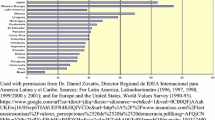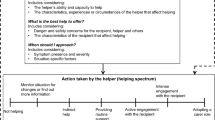Abstract
Relationships between human services program models and help-giving practices, and between both program models and help-giving practices and help-seeker control appraisals were examined in a study of 107 low socioeconomic background families. Three kinds of human services agencies were included in the study, each of which differed in terms of their implicit and explicit assumptions about the families they served and the roles professionals and families played as part of helping relationships. Results support the hypotheses that (a) a program philosophy that was family centered would be associated with more empowering help-giving practices compared to more professionally centered philosophies and (b) a family-centered program philosophy and empowering help-giving practices would be related to an enhanced sense of personal control over needed supports and resources from a target help-giver.
Similar content being viewed by others
References
Able-Boone, H., Sandall, S. R., Loughry, A., & Frederick, L. L. (1990). An informed, family-centered approach to Public Law 99–457: Parental views,Topics in Early Childhood Special Education, 10, 100–111.
Affleck, G., Tennen, H., & Rowe, J. (1991).Infants in crisis: How parents cope with newborn intensive care and its aftermath. New York: Springer-Verlag.
Bandura, A. (1977). Self-efficacy: Toward a unifying theory of behavioral change.Psychological Review, 84, 191–215.
Brickman, P., Rabinowitz, V., Karuza, J., Coates, D., Cohn, E., & Kidder, L. (1982). Models of helping and coping.American Psychologist, 37, 368–384.
Brickman, P., Kidder, L. H., Coates, D., Rabinowitz, V., Cohn, E., & Karuza, J. (1983). The dilemmas of helping: Making aid fair and effective. In J. D. Fisher, A. Nadler, & B. M. DePaulo (Eds.),New directions in helping: Vol. 1. Recipient reactions to aid (pp. 18–51). New York: Academic Press.
Bronfenbrenner, U. (1979).The ecology of human development. Cambridge, MA: Harvard University Press.
Carkhuff, R. R., & Anthony, W. A. (1979).The skills of helping. Amherst, MA: Human Resource Development Press.
Carmines, F., & Zeller, R. (1979).Reliability and validity assessment. Newbury Park, CA: Sage.
Coates, D., Renzaglia, G. J., & Embree, M. C. (1983). When helping backfires: Help and helplessness. In J. D. Fisher, A. Nadler, & B. M. DePaulo (Eds.),New directions in helping: Vol. 1. Recipient reactions to aid (pp. 251–279). New York: Academic Press.
Cohen, J., & Cohen, P. (1983).Applied multiple regression/correlation analysis for the behavioral sciences (2nd ed.). Hillsdale, NJ: Erlbaum.
Deal, A. G., & Pletcher, L. (1991). Professionally centered to family centered: Clarifying the continuum.Family Enablement Newsletter, 3, 3.
DePaulo, B., Nadler, A., & Fisher, J. (Eds.). (1983).New directions in helping: Vol. 2. Help-seeking. New York: Academic Press.
Dunst, C. J. (1991, February).Empowering families: Principles and outcomes. Presentation made at the 4th Annual Research Conference “A System of Care for Children's Mental Health: Expanding the Research Base,” Tampa, FL.
Dunst, C. J., Johanson, C., Trivette, C. M., & Hamby, D. (1990). Family-oriented early intervention policies and practices: Family-centered or not?Exceptional Children, 58, 115–126.
Dunst, C. J., & Trivette, C. M. (1987). Enabling and empowering families: Conceptual and intervention issues.School Psychology Review, 16, 443–456.
Dunst, C. J., & Trivette, C. M. (1988). Helping, helplessness and harm. In J. Witt, S. Elliott, & F. Gesham (Eds.),Handbook of behavior therapy in education (pp. 343–376). New York: Plenum Press.
Dunst, C. J., Trivette, C. M., Davis, M., & Weeldreyer, J. C. (1988). Enabling and empowering familes of children with health impairments.Children's Health Care, 17, 71–81.
Dunst, C. J., Trivette, C. M., & Deal, A. G. (1988).Enabling and empowering families: Principles and guidelines for practice. Cambridge, MA: Brookline Books.
Dunst, C. J., Trivette, C. M., Gordon, N. J., & Pletcher, L. L. (1989). Building and mobilizing informal family support networks. In G. S. Singer & L. K. Irvin (Eds.),Support for caregiving families: Enabling positive adaptation to disability (pp. 121–142). Baltimore: Paul H. Brookes.
Dunst, C. J., Trivette, C. M., Gordon, N., & Starnes, L. (1993). Family-centered case management practices: Characteristics and consequences. In G. Singer & L. Powers (Eds.),Families, disabilities, and empowerment. Baltimore: Brookes.
Dunst, C. J., Trivette, C. M., & Hamby, D. (1995). Measuring the help-giving practices of human services programs practitioners.Human Relations, 49, 815–835.
Dunst, C. J., Trivette, C. M., & LaPointe, N. (1992). Toward clarification of the meaning and key elements of empowerment.Family Science Review, 5(1/2), 111–130.
Dunst, C. J., Trivette, C. M., Starnes, A. L., Hamby, D. W., & Gordon, N. J. (1993).Building and evaluating family support initiatives. Baltimore: Brookes.
Dunst, C. J., Trivette, C. M., & Thompson, R. L. (1991). Supporting and strengthening family functioning: Toward a congruence between principles and practice.Prevention in Human Services, 9, 19–43.
Feldt, L. (1961). The use of extreme groups to test for the presence of a relationship.Psychometrika, 26, 302–316.
Fisher, J. D., Nadler, A., & DePaulo, B. M. (Eds.). (1983).New directions in helping: Vol. 1. Recipient reactions to aid. New York: Academic Press.
Garrett, A. (1982).Interviewing: Its principles and methods. New York: Family Service Association of America.
Goldin, E., & Doyle, R. E. (1991). Counselor predicate usage and communication proficiency on ratings of counselor empathic understanding.Counselor Education and Supervision, 30, 212–224.
Heller, K. (1992). Ingredients for effective community change: Some field observations.American Journal of Community Psychology, 20, 143–163.
Hollingshead, A. B. (1975).Four-factor index of social status. Yale University Department of Sociology, New Haven, CT.
Hutchinson, J. R., & Nelson, K. E. (1985). How public agencies can provide family-centered services.Social Casework, 66, 367–371.
Jaccard, J., Turrisi, R., & Wan, C. (1990).Interaction effects in multiple regression. Thousand Oaks, CA: Sage.
Karuza, J., Jr., Zevon, M., Gleason, T., Karuza, C., & Nash, C. (1990). Models of helping and coping, responsibility attributions and well-being in community elderly and their helpers.Psychology and Aging 5, 194–208.
Karuza, J., Jr., Zevon, M. A., Rabinowitz, V. C., & Brickman, P. (1982). Attribution of responsibility by helpers and recipients. In T. A. Wills (Ed.),Basic processes in helping relationships (pp. 107–129). New York: Academic Press.
Langer, E., & Benevento, A. (1978). Self-induced dependence.Journal of Personality and Social Psychology, 36, 866–893.
Lord, J., & Farlow, D. M. (1990). A study of personal empowerment: Implications for health promotion.American Journal of Health Promotion, 5, 2–8.
Memmott, J., & Brennan, E. (1988). Helping orientations and strategies of natural helpers and social workers in rural settings.Social Work Research and Abstracts, 24(2), 15–20.
McGonigel, M. J., Kaufmann, R. K., & Johnson, B. H. (1991). A family-centered process for the individualized family service plan.Infants and Young Children, 1, 46–56.
Michlitsch, J., & Frankel, S. (1989). Helping orientations: Four dimensions.Perceptual and Motor Skills, 69, 1371–1378.
Morrison, J. K., Bushnell, J. D., Hanson, G. D., Fentlman, J. R., & Holdridge-Crane, S. (1977). Relationship between psychiatric patients' attitudes toward mental illness and attitudes of dependence.Psychological Reports, 41, 11–94.
Nadler, A., Fisher, J. D., & DePaulo, B. M. (Eds.). (1983).New directions in helping: Vol 3. Applied perspectives on help-seeking and-receiving. New York: Academic Press.
Nelson, K. D. (1990). Three models of family-centered placement prevention services.Child Welfare, 69(1), 3–21.
O'Leary, A. (1985). Self-efficacy and health.Behavior Research and Therapy, 23, 437–451.
Ozer, E., & Bandura, A. (1990). Mechanisms governing empowerment effects: A self-efficacy analysis.Journal of Personality and Social Psychology, 58, 472–486.
Pettigrew, T. (1983). Seeking public assistance: A stigma analysis. In A. Nadler, J. Fisher, & B. DePaulo (Eds.),New directions in helping: Vol. 3. Applied perspectives on help-seeking and-receiving (pp. 273–292). New York: Academic Press.
Prestby, J., Wandersman, A., Florin, P., Rich, R., & Chavis, D. (1990). Benefits, costs, incentive management and participation in voluntary organizations: A means to understanding and promoting empowerment.American Journal of Community Psychology, 18, 117–149.
Rabinowitz, V. C., Karuza, J., Jr., & Zevon, M. A. (1984). Fairness and effectiveness in premeditated helping. In R. Folger (Ed.),The sense of injustice (pp. 63–92). New York: Plenum Press.
Rabinowitz, V. C., Zevon, M. A., & Karuza, J. (1988). The models and modes of psychotherapy: An attributional analysis. In L. Abramson (Ed.),Social cognition and clinical psychology (pp. 190–203). New York: Guilford.
Rappaport, J. (1981). In praise of paradox: A social policy of empowerment over prevention.American Journal of Community, 9, 1–25.
Rappaport, J. (1987). Terms of empowerment/exemplars of prevention: Toward a theory for community psychology.American Journal of Community Psychology, 15, 121–148.
Riessman, F. (1990). Restructuring help: A human services paradigm for the 1990s.American Journal of Community Psychology, 18, 221–230.
Schunk, D., & Carbonari, J. (1984). Self-efficacy models. In J. Matarazzo, S. Weiss, J. A. Herd, N. Miller, & S. M. Weiss (Eds.),Behavioral health: A handbook of health enhancement and disease prevention (pp. 230–247). New York: Wiley.
Skinner, E. (1995).Perceived control, motivation, and coping. Thousand Oaks, CA: Sage.
Swift, C. (1984). Empowerment: An antidote for folly. In J. Rappaport, R. Hess, & C. Swift (Eds.),Studies in empowerment: Steps toward understanding and action (pp. xi-xv). New York: Haworth.
Swift, C., & Levin, G. (1987). Empowerment: An emerging mental health technology.Journal of Primary Prevention, 8(1/2), 71–94.
Trivette, C. M., & Dunst, C. J. (1994).Helpgiving Practices Scale. Unpublished scale, Center for Family Studies, Western Carolina Center, Morganton, NC.
U. S. Bureau of the Census. (1992).Poverty in the United States: 1991 (Current population reports, Series P-60, No. 181). Washington, DC: U.S. Government Printing Office.
Wandersman, A., & Florin, P. (1990). Citizen participation, voluntary organizations and community development: Insights for empowerment through research.American Journal of Community Psychology, 18, 49–177.
Whitmore, E., & Kerans, P. (1988). Participation, empowerment and welfare.Canadian Review of Social Policy, 22, 51–60.
Zimmerman, M. A. (1990a). Toward a theory of learned hopefulness: A structural model analysis of participation and empowerment.Journal of Research in Personality, 24, 71–86.
Zimmerman, M. A. (1990b). Taking aim on empowerment research: On the distinction between individual and psychological concepts.American Journal of Community Psychology, 18, 169–177.
Zimmerman, M. A., Israel, B., Schulz, A., & Checkoway, B. (1992). Further explorations in empowerment theory: An empirical analysis of psychological empowerment.American Journal of Community Psychology, 20, 707–727.
Zimmerman, M. A., & Rappaport, J. (1988). Citizen participation, perceived control, and psychological empowerment.American Journal of Community Psychology, 16, 725–750.
Author information
Authors and Affiliations
Additional information
Appreciation is extended to Mary E. Brown and Pat Condrey for preparation of the manuscript. The research was supported, in part, by a grant from the National Institute of Child Health and Human Development (H023000-62).
Rights and permissions
About this article
Cite this article
Trivette, C.M., Dunst, C.J. & Hamby, D. Characteristics and consequences of help-giving practices in contrasting human services programs. Am J Commun Psychol 24, 273–293 (1996). https://doi.org/10.1007/BF02510402
Issue Date:
DOI: https://doi.org/10.1007/BF02510402




